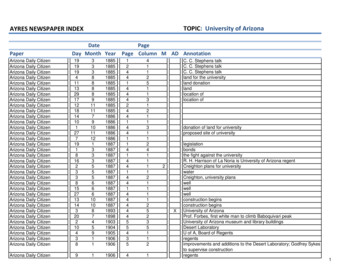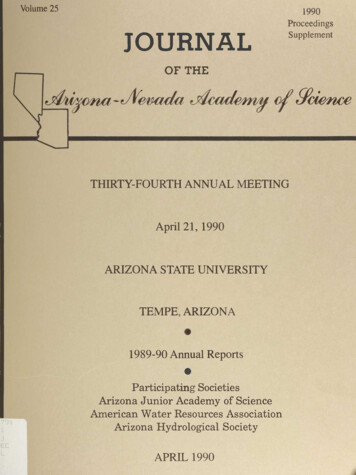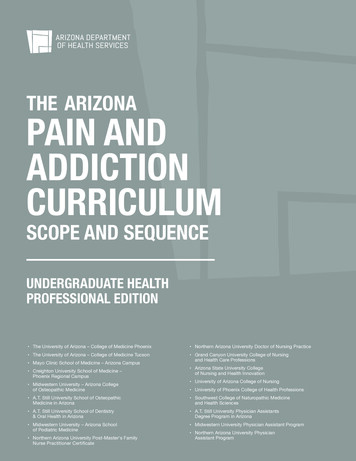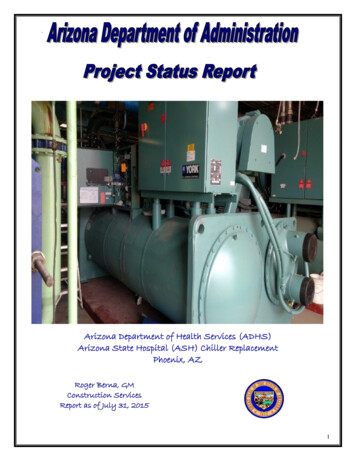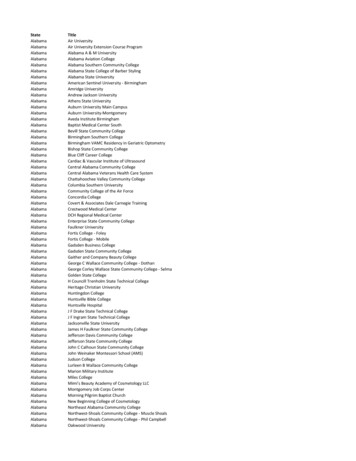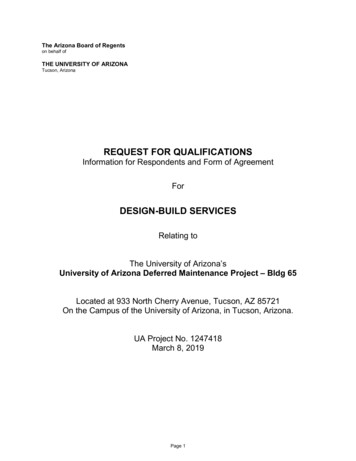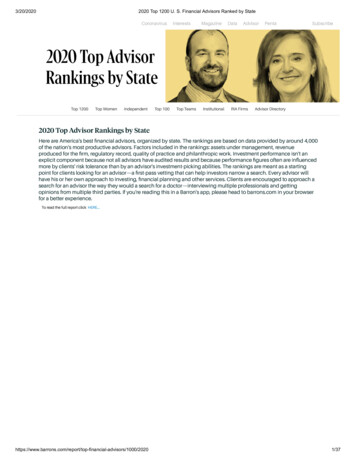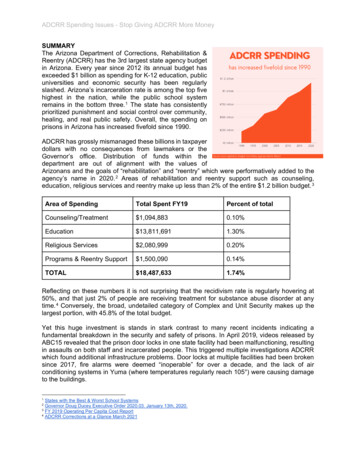
Transcription
ADCRR Spending Issues - Stop Giving ADCRR More MoneySUMMARYThe Arizona Department of Corrections, Rehabilitation &Reentry (ADCRR) has the 3rd largest state agency budgetin Arizona. Every year since 2012 its annual budget hasexceeded 1 billion as spending for K-12 education, publicuniversities and economic security has been regularlyslashed. Arizona’s incarceration rate is among the top fivehighest in the nation, while the public school systemremains in the bottom three. 1 The state has consistentlyprioritized punishment and social control over community,healing, and real public safety. Overall, the spending onprisons in Arizona has increased fivefold since 1990.ADCRR has grossly mismanaged these billions in taxpayerdollars with no consequences from lawmakers or theGovernor’s office. Distribution of funds within thedepartment are out of alignment with the values ofArizonans and the goals of “rehabilitation” and “reentry” which were performatively added to theagency’s name in 2020. 2 Areas of rehabilitation and reentry support such as counseling,education, religious services and reentry make up less than 2% of the entire 1.2 billion budget. 3Area of SpendingTotal Spent FY19Percent of totalCounseling/Treatment 1,094,8830.10%Education 13,811,6911.30%Religious Services 2,080,9990.20%Programs & Reentry Support 1,500,0900.14%TOTAL 18,487,6331.74%Reflecting on these numbers it is not surprising that the recidivism rate is regularly hovering at50%, and that just 2% of people are receiving treatment for substance abuse disorder at anytime. 4 Conversely, the broad, undetailed category of Complex and Unit Security makes up thelargest portion, with 45.8% of the total budget.Yet this huge investment is stands in stark contrast to many recent incidents indicating afundamental breakdown in the security and safety of prisons. In April 2019, videos released byABC15 revealed that the prison door locks in one state facility had been malfunctioning, resultingin assaults on both staff and incarcerated people. This triggered multiple investigations ADCRRwhich found additional infrastructure problems. Door locks at multiple facilities had been brokensince 2017, fire alarms were deemed “inoperable” for over a decade, and the lack of airconditioning systems in Yuma (where temperatures regularly reach 105 ) were causing damageto the buildings.States with the Best & Worst School SystemsGovernor Doug Ducey Executive Order 2020.03. January 13th, 2020.3FY 2019 Operating Per Capita Cost Report4ADCRR Corrections at a Glance March 202112
ADCRR Spending Issues - Stop Giving ADCRR More MoneyADC Spending FY19 1,200,000,000 1,000,000,000 800,000,000Remaining Budget, 561,356,706.00 600,000,000 400,000,000Security, 487,970,096.00Religious Services, 2,080,999.00 200,000,000Programs Reentry, 1,500,090.00Education, 13,811,691.00 0Counseling/Treatment, 1,094,833.00
ADCRR Spending Issues - Stop Giving ADCRR More MoneyOver 54 million was appropriated to repairing these systems in 2019, 5 as well as 17.7 millionapproved by the Joint Committee on Capital Review (JCCR) to be transferred from the generalfund. 6 There is virtually no attempt on the part of the legislature, the Department, or any othergovernment body to monitor and report on how these funds were spent, what improvements havebeen made, or what the outcomes have been.In 2021, the escape of two men from the Florence complex and the arrest of two correctionalofficers for bringing contraband into prisons indicate that these huge investments have notadequately addressed the security lapses in ADCRR. Yet there is no attempt to hold thedepartment accountable for these serious lapses in security.The second largest portion of the ADCRR budget is for contracts with privatized healthcareproviders which makes up 15.6% of the budget. Spending in this area has increased significantlydue to the ongoing Parsons v. Shinn lawsuit and court mandated increases in payments.Originally, ADCRR projected that privatizing the prison healthcare system would save the state 5 million dollars. In 2011, state-run prison healthcare costs were 117 million. The total in 2021after outsourcing medical services was 198 million - an 80 million dollar increase. 7Problems associated with delivery of prison healthcare have only increased since the COVID-19pandemic was declared in March 2020. Lack of proper prevention techniques and indifferencefrom staff members made the disease spread quickly in the congregate settings.Infection rates in ADCRR are three times higher than the general Arizona population.COVID-19 death rates inside are largely unknown as the ADCRR dashboard regularly removesdata on people who have “confirmed death” without explanation, making it impossible to monitorthe total number of COVID-19 deaths. 8 No one should be sentenced to death by COVID-19 inArizona prisons, but between the improper healthcare and poor COVID-19 management, that isexactly what is happening.In recent years, one of the department’s biggest investments has been updating the ArizonaInmate Management System (AIMS), which was called “archaic and of limited value”. Since 2014,the legislature allocated nearly 31 million to ADCRR to update this system. In November 2019,ADCRR went live with the replacement system, now called Arizona Corrections InformationSystem (ACIS). Although frontline staff had asked hold off because there were 14,000 knownissues with the software, ADCRR administrators moved forward.This reckless decision by leadership has caused a myriad of issues for people in prison: Inability to track health care resulting in prescriptions running out or not being distributed Incorrect head count numbers posing serious security risks Property of incarcerated individuals not being tracked Commissary and financial accounts failing to be kept up to date Religious affiliations improperly categorized, preventing some people from receivingspecial meals, attending services, or otherwise being able to practice their faith Inaccurate security classifications or gang affiliations, which can keep people in unsafehousing conditions or solitary confinement Inability to calculate changes to sentence length resulting from recent legislation(SB1310), which kept people past their release dateFY 2021 Appropriations ReportJCCR Minutes - June 18, 20197JLBC State Department of Corrections Appropriation reports8Twitter post, Jimmy Jenkins. March 15, 202156
ADCRR Spending Issues - Stop Giving ADCRR More MoneyCurrently, the ADCRR population is at the lowest recorded level in nearly a decade, yet spendinghas remained extremely high. The current population stands at 36,704 people 9 with a 1.2 billionbudget. The last time ADCRR had a lower population was in 2006, with 35,892 people, andfunding was just 707.7 million. 10ACCOUNTABILITY IS NEEDEDThese are only the latest in a long-standing pattern of high-profile problems in ADCRR over thelast year. Other, ongoing issues include lack of proper meals for religious beliefs 11 and the forcedserving of expired food, 12 negligent healthcare for pregnant women, 13 contaminated water inmultiple facilities, 14 and deficient mental health services resulting in self harm incidents andsuicides. 15 Incarcerated people are told to follow the ADCRR grievance procedure 16 to addressthese issues, but it has proven ineffective. Grievances are often lost or thrown out due toimpossibly narrow timelines and system barriers. 17 Frustration with the lack of accountability andoversight has resulted in incarcerated people holding peaceful protests such as the hunger strikeat the Eyman facility in March 2021. 18Many of these issues would not be known without intensive legal intervention, such as with theParsons v. Shinn medical class action lawsuit, or the efforts of ADCRR employee whistleblowerswho reached out to the media to expose these systemic failures. These workers took action atgreat risk to themselves and their careers, and explicitly stated that they did so because theirpleas to prison administration were being ignored. There have been reports of retribution againstprison staff who smuggled video evidence of the malfunctioning locks at the Lewis prison. In oneheartbreaking case, one of the Lewis prison whistleblowers tragically took her own life. 19Oversight and accountability of ADCRR is essential. The power to literally deprive 40,000 peopleof their freedom is a grave government responsibility that demands the highest level ofaccountability. The Department literally assumes life and death power over individuals in itscustody. It is fundamentally responsible for their health and wellbeing, not to mention fulfilling thestated purpose of the agency, which is rehabilitation and ‘correcting’ behavior. Add to this theexpenditure of the third largest share of the state budget, and it is far past time for Arizona toinstitute a greater level of accountability over ADCRR.As a state agency, the Department falls under the Executive Branch, and is accountable to theoffice of the Governor. Unfortunately, Governor Doug Ducey has taken a hands-off approachwhen it comes to ADCRR. There is currently no statute that affords the legislative branch anylevel of access or authority over this department. Legislators may request meetings, information,and even prison tours from ADCRR, but the agency regularly delays or dismisses these requests.Since 2019, Democratic law makers have submitted fourteen requests to ADCRR requestinginformation, policies, and data on media policies, phone call costs and COVID-19 protocols. OnlyADCRR Corrections at a Glance March 2021Bureau of Justice Statistics Prisoners in 2007, FY 2007 Appropriations Report - Budget Highlights FY 200711Jewish Inmates Sue Arizona Prisons Over Kosher Meal Change.12Inmate Kitchen Workers Say They Were Forced To Serve Expired Meat In Arizona Prisons13Arizona prisons have a history of women giving birth in cells14Another Arizona state prison complex facing water shortage issues.15'A Silent Epidemic,' Self-Harm Incidents Surging In Arizona Prisons16DO 802 - Inmate Grievance Procedure17DIGGING DEEPER: COVID-19 death toll rises inside Arizona prisons18Inmates On Hunger Strike Protesting Arizona Prison Conditions19Prison whistleblower who exposed unsafe conditions in Arizona facility found dead910
ADCRR Spending Issues - Stop Giving ADCRR More Money65% of these requests were fulfilled. 20 Those that did receive a response were often lackingcrucial information. Tours of prison facilities have been requested by lawmakers from both sidesof the aisle, but none have been permitted. 21 Corrections staff have also largely been absent fromlegislative committee hearings this session, even when the bills have a direct bearing on theoperations of ADCRR.A bill (HB2167) was introduced this session to establish an oversight committee and ombudsmanoffice to oversee the ADCRR, but the bill stalled in the Senate when Judiciary Chair WarrenPetersen refused to put it on the agenda. It is hard to fathom an equivalent situation in which anyentity with a budget this large, a responsibility this important, and a track record this terrible wouldbe allowed to operate in total secrecy with no accountability for its failures, its wide-reachingimpact on Arizona’s budget, collective safety, and the lives of so many individuals.ADCRR continues to get a pass in the name of “public safety,” but there is no evidence thatincreased incarceration and punishment does anything to make Arizonans safer. This ineffectiveand harmful narrative which only exacerbates problems as opposed to solving them.SOLUTION:1) Immediately conduct a fiscal and performance audit of ADCRR and its contractors.An impartial body should review the millions of dollars allocated to ADCRR and present adetailed report on exactly how this funding was spent and what the outcomes have been.2) Institute an immediate spending cap on the ADCRR.Funding levels should be reduced to in proportion to the decrease in population. Adjustedfor inflation, this means that no more than 950 million should be allocated to ADCRR.3) Develop and staff an Independent Corrections Ombudsman’s Office.This office would oversee every aspect of the ADCRR and ensure accountability on theissues outlined in this report. The cost of this office has been estimated at 1.5 million. 22The monies saved through reducing the corrections budget (per #2 above) should bereallocated to establish, staff, and maintain this office.4) Require fiscal notes for all legislation that would increase the prison population,beginning January 1, 2022.When any legislation is introduced which would result in individuals being incarcerated orincrease sentencing lengths for an existing felony, a fiscal note must be included. Thisshall be prepared by the Joint Legislative Budget Committee and attached to the bill attime of its first hearing. The fiscal note shall be made available on the Arizona StateLegislature’s website.5) Immediately and permanently rescind the Request for Information (RFI) released byADCRR on December 24th, 2020 for the addition of over 2,700 private prison beds.Given the reduction in the prison population by over 5,000 people, this contract isunnecessary. Based on the current private prison per diem of 54.59, rescinding the RFIwould result in a cost avoidance of at least 54 million.Personal Communication with Democratic House and Senate Staff, completed April 16th, 2021.Twitter post, Rep. Diego Rodriguez. November 9th, 201922Fiscal Note, JLBC, BILL # HB 2167. January 21st, 2021.2021
ADCRR Spending Issues - Stop Giving ADCRR More MoneyROLE OF THE AMERICAN RESCUE PLANSUMMARYUnder President Joe Biden’s American Rescue Plan, Arizona is being given at least 12.3 billiondollars - more than the entire state budget in FY2021. 23 Some of this money is required to attendto certain needs, including prisons. According to the release plan by the White House, prisonswith congregate settings should be prioritized for services. 24 This aligns with the current infectionrate in Arizona prisons, which is three times higher than the general population. 25 Areasspecifically outlined in this report for prisons include: Ensuring high-quality COVID-19 data is available, including testing, treatment, andinfection rates for people in prisons, and demographic data should be included. Distribute vaccines to facility staff and incarcerated individuals in jails, prisons anddetention centers, as well as ensuring adequate mitigation measures are in place toprevent further spread. Ensure prisons are following sound public health guidance. The President will issue anExecutive Order to require the Bureau of Prisons and ICE detention facilities to evaluatetheir COVID-19 protocols, release data on the spread of COVID-19 in facilities and usefederal grant programs to create incentives for state and local facilities to adhere to soundpublic health guidance.Additionally, there are areas which could be used to reduce the prison population, address rootcauses of harm, reduce the potential for recidivism, and build safety outside of the carceral state.Funding allocations to the areas of Human Services and Housing include: Expanding eligibility for SNAP benefits and increasing the monthly allowance. Funding that targets prevention programs of domestic violence and child abuse prevention Increasing housing options for Veterans who are homeless via the State Veteran’s Homesone-time funding Multiple areas of rental, mortgage and utility assistance to keep people in their homes Expansion of homeless services, affordable housing development and emergencyvoucher monies to promote a housing-first model to build stability and safety.SOLUTIONFunds from the American Rescue Plan should be used to mitigate COVID-19 spread insideprison, as well as aid in reentry services such as access to food/SNAP support, transitionalhousing placement, and Veteran-specific care upon release. Instead of adding to the alreadybloated Corrections budget, these funds should be leveraged to divert individuals from prison andto invest in the wellbeing and success of returning citizens to break the cycle of incarceration.Such expenditures should prioritize investment in community-based programs where people canobtain support and healing through substance abuse treatment, trauma counseling, and povertyreduction efforts.FY2021 general fund budget was 11.6 Billion via FY 2021 Appropriations ReportNational Strategy for the COVID-19 Response and Pandemic Preparedness25ADCRR COVID-19 Dashboard Arizona Department of Corrections, Rehabilitation and Reentry2324
Arizonans and the goals of "rehabilitation" and "reentry" which were performatively added to the agency's name in 2020. 2 Areas of rehabilitation and reentry support such as counseling, education, religious services and reentry make up less than 2% of the entire 1.2 billion budget. 3. Area of Spending Total Spent FY19 Percent of total


